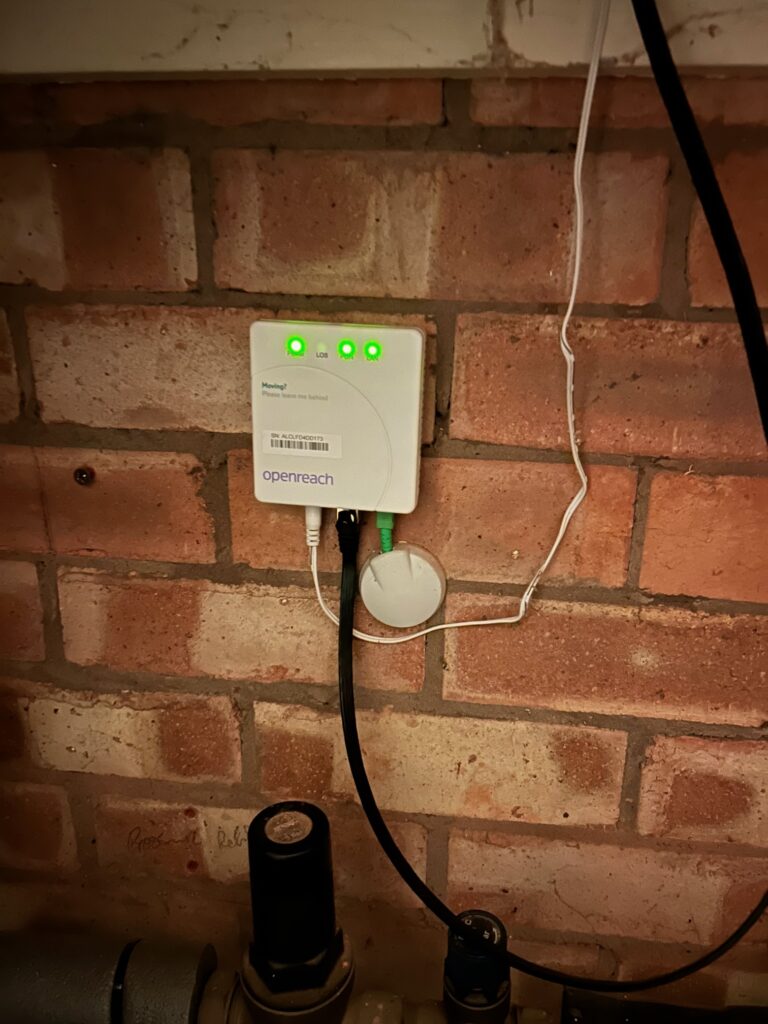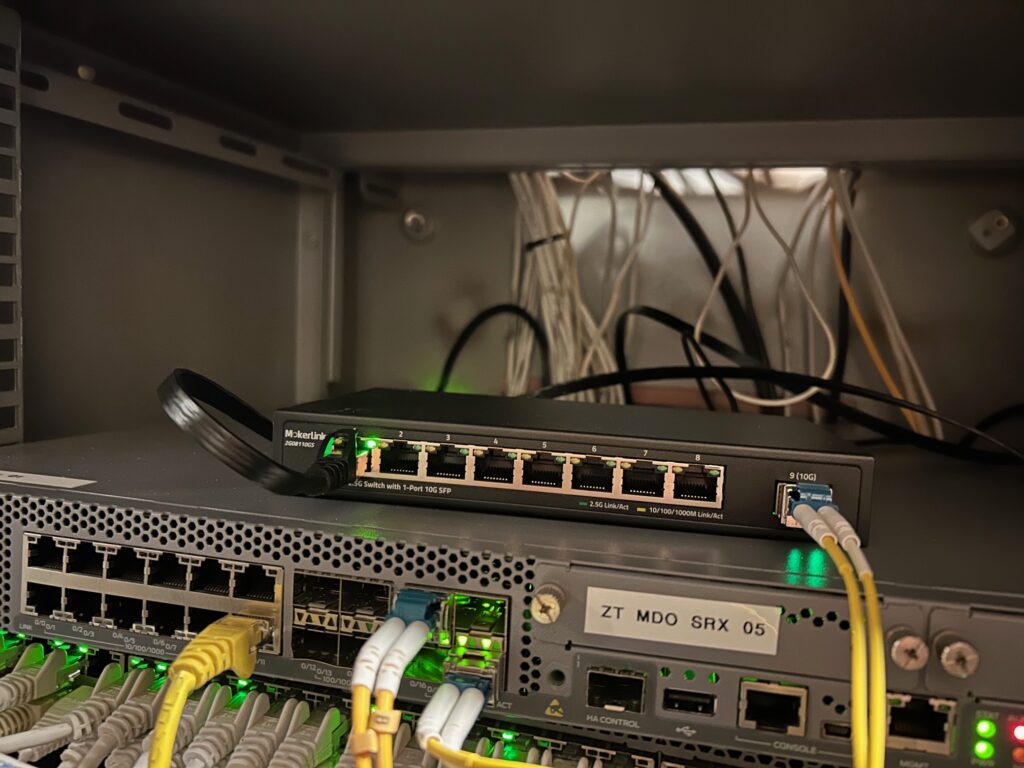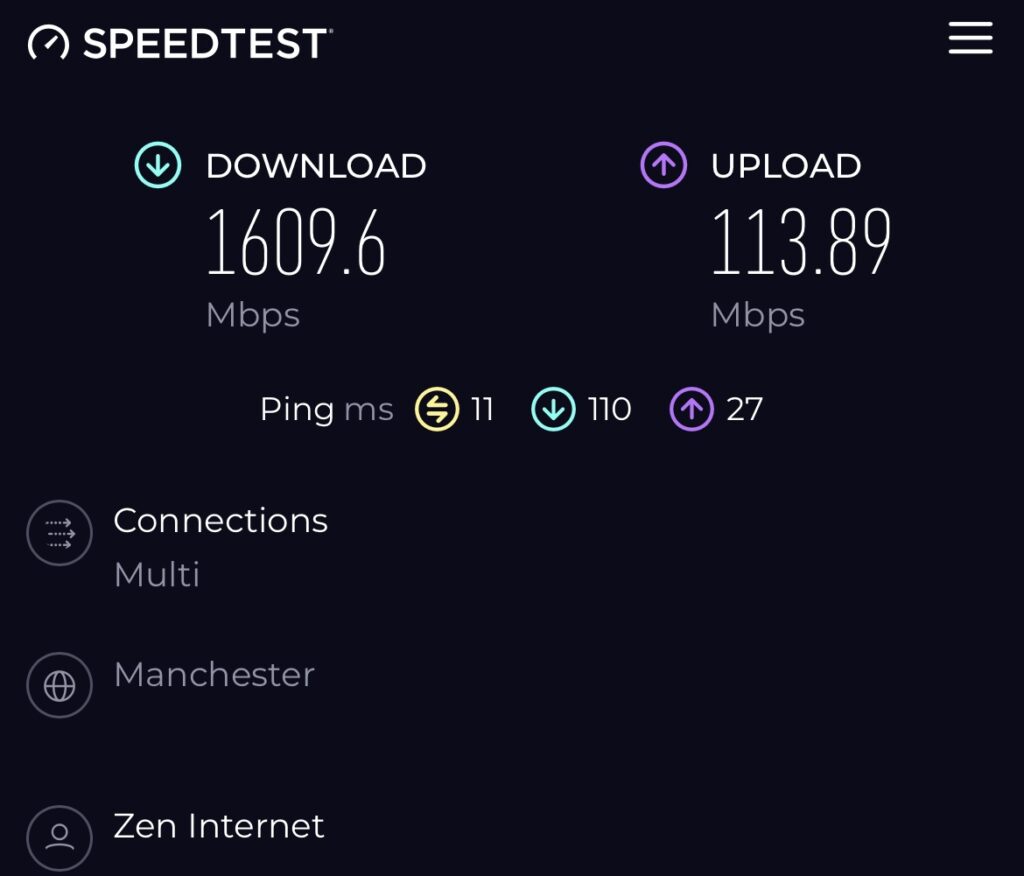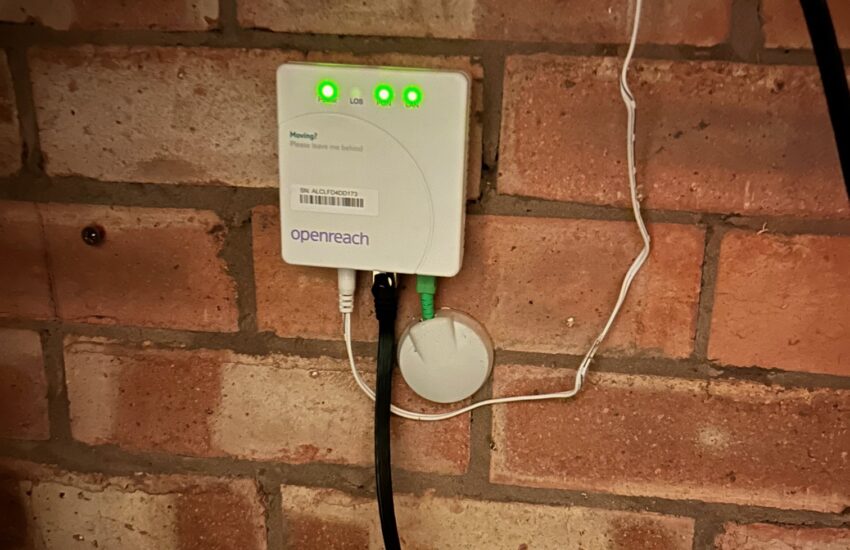Intro
BT OpenReach have fairly recently launched a new FTTP service, which they are offering to ISPs who use the OpenReach FTTP network. This gives a theoretical maximum download speed of 1,600Mbps and an upload speed of 120Mbps. They’re rolling this out across their network and it is quickly becoming available to more customers.
I recently upgraded my 900Mbps package to 1.6G and have, below, documented the minor intricacies of this.
The Install
The install requires a visit from OpenReach, and the usual 5+ week wait time which comes with that. They simply need to swap your ONT for a new one. It would seem sensible if they just posted them out and asked people to do it themselves, but efficiency isn’t in BT’s manifesto. Here’s the new ONT:

The ONT
I had presumed the OpenReach ONT would come with a 10Gbps Ethernet port on it. It actually comes with a 2.5Gbps copper Ethernet port. I’m ashamed to say, as somebody who was pretty heavily involved in Enterprise and Service Provider networking only 4 or so years back, this new standard passed me by. 2.5Gbps seems to be developing as the new access layer standard, with many new switches being 2.5g, and 2.5g NICs costing pretty much the same as 1g NICs. Both 2.5Gb Ethernet and 5Gb Ethernet are designed to run over Cat5e, which means they’ll retrofit into most existing installations.
Upgrading your Network
The observant amongst you will have noticed that this is the first time residential broadband has gone above 1Gbps. This is significant, because the vast majority of consumer hardware (routers, switches, network cards, etc.) run at 1Gbps. As such, you may need to upgrade your network to take full advantage of the 1.6Gbps speeds.
Your ISP will likely send you a new router, not least because the old one probably doesn’t have a 2.5Gbe port on it. Do some research into the capabilities of this router. Zen, for example, will send you Amazon’s Eero Pro 6 router. This has 1x 2.5Gb port and 1x 1Gb port. As such, you won’t get 1.6Gbps on a single device. To take advantage of the full speed, you will need to be downloading heavily from 2 or more devices – at least one of which is on WiFi. Honestly, I don’t see much benefit in this unless you have a freakishly busy household. Zen will send you an Amazon Eero 7 Max, for an additional £20 per month. This does come with 10Gb ports so a single device with a 10Gb NIC could take full advantage of the bandwidth.
My network already has 10Gb capabilities and I have a few devices connected at 10G. Problem is, I have no 2.5Gb ports so cannot connect the new ONT to my existing hardware. After researching around, I opted to buy the relatively inexpensive MokerLink 8 Port 2.5G Ethernet Switch with 10G SFP, 8 x 2.5G Base-T Ports. This allows me to “convert” the 2.5Gb ONT to 10Gb – I connected the ONT and a 10Gb port from my existing router into this switch. This is working well – no complaints so far.
I also found these interesting SFP+ modules on fs.com. They seem to support multiple rates. I contacted FS Support via their chat and they told me this wouldn’t work in a device which does not natively support 2.5Gb/s rates on an SFP+ port. They e-mailed me the next day saying they were wrong and in fact it would work. I had ordered the MokerLink by this point, so I haven’t tried it. Worth a punt if you want a fairly tidy set up.
Here’s the MokerLink in action:

Router Config
It’s easy enough to configure a router not supplied by your ISP to connect to the service. Just set up PPPoE using the username and password provided by your ISP. Here’s the relevant config from my Juniper SRX. This will give dual-stack IPv4 and IPv6. If your ISP doesn’t provide IPv6, you can skip that bit.
interfaces {
xe-0/0/19 {
unit 0 {
description "WAN to OpenReach ONT";
encapsulation ppp-over-ether;
}
}
pp0 {
description "PPPoE to Zen";
unit 0 {
ppp-options {
chap {
default-chap-secret "*****";
local-name "zen*****@zen";
passive;
}
}
pppoe-options {
underlying-interface xe-0/0/19.0;
idle-timeout 0;
auto-reconnect 10;
client;
}
family inet {
negotiate-address;
}
family inet6 {
dhcpv6-client {
client-type stateful;
client-ia-type ia-pd;
rapid-commit;
client-identifier duid-type duid-ll;
retransmission-attempt 9;
update-server;
}
dad-disable;
}
}
}
}Is it actually 1.6Gbps?
Yaknow what..? Surprisingly, it is. I’m getting 1609Mbps down and 114Mbps up. Pretty happy with that.


Please can you share your router config for using the BT FTTP service without using a BT provided router.
I would like to do this with either a Cisco router or a Palo Alto firewall.
Sure 🙂 I just updated the post with config from my Juniper SRX. Should be easy enough to translate to Cisco syntax.
Dang that upload is pretty poor. Such a scam that they don’t offer 1000/1000. Who needs 1600.
Yeh… BT, in their infinite wisdom, has rolled their fibre network on GPON. Almost everybody else is using AE. BT now has the fastest download speed of residential providers with a crappy upload to compensate for it
Random question. My son just moved into student house and has the openreach connection on your first image but someone has removed the power supply. None seems to know what spec it should be. Do you?
Just checked mine. It’s 12v / 0.5A / Centre Positive. Any 12v adapter that fits in the hole should work
Hi to all! just wondering if you can answer my queries. I’m on Vodafone Pro II 900mb FTP download, I wish to move to Pro III which means I would have a wifi7 Pro III Router sent out by Vodafone but only on 900mb. Will I need a New ONT box? current one was fitted 2yrs ago when I changed over to FTP. Problem is Vodafone won’t offer me as an existing customer 1.6gb dowmload package only for new customers, hence new ONT box + port change in Exchange “New Installation” My ONT box starts with ALCF93 can anyone clarify if this needs an Engineer visit……
Yeh. I was on 900 before upgrading. You’ll need new ONT and a new Router with a 2.5g WAN port
Now moved from Vodafone Pro II to Pro III. New router is wifi 7 had nothing but problems connecting to internet, worked for a few days ok then Vodafone pushed out a firmware update that caused problems spent 1.5days on phone with Vodafone who then passed it back to backend team. They rolled it back to original firmware which I had tried on device reset button. Came back up on internet but! Constantly dropping out all the time. Not giving out ip addresses from router. Gave up with this router switched back to my old router wifi 6e which came with pro II package had no problems what so ever not dropped one been up now for 6days. Having spent hours on web seems it’s common with Vodafones Wifi 7 pro III router. Question is now what to do about wifi 7 router, just for record my old one is triband 2.5/5/6ghz new one is only 2.5/5ghz? I do have 2.5g ports on old router so what to do press vodafone to fix or just stay with old router, any comments would be welcome